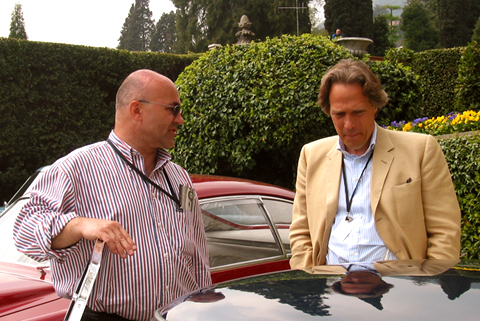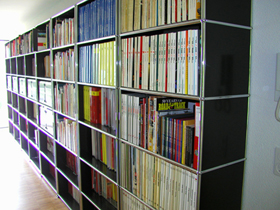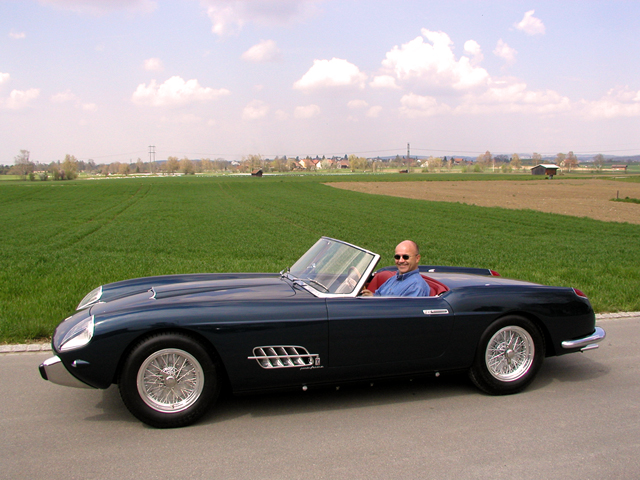|
 "The
world’s top restorers, collectors, dealers and auction houses
often choose to consult with an expert when searching for
historical information on important Ferraris and the first choice
among those in the know is almost always world-renowned Ferrari
expert and historian Marcel Massini." "The
world’s top restorers, collectors, dealers and auction houses
often choose to consult with an expert when searching for
historical information on important Ferraris and the first choice
among those in the know is almost always world-renowned Ferrari
expert and historian Marcel Massini."
There
is something remarkable about the name “Ferrari.” Even without a
powerful prewar legacy like those of Bugatti, Rolls Royce,
Mercedes Benz, Alfa Romeo, Maserati and Jaguar, the cars bearing
Enzo Ferrari’s name have, in a relatively short span of time,
developed one of the most diverse and wide-spread followings of
any automotive marque. While all of these makes have their own
devout followers, experts and historians, the immense society that
has blossomed around the cars from Maranello is comprised of a
surprisingly wide array of individuals from around the world, all
of which have, at some point in their lives, become completely
spellbound by the marque. As a result, Ferrari is one of the most
studied and researched automotive subjects among historians and
experts around the globe with an astounding number of books and
articles written and published on the subject during the company’s
short history.
Despite all of this available material, there is surprisingly
still so much that remains unknown and the amount of inaccurate
information that is already circulating in print is staggering.
For these reasons, the world’s top restorers, collectors, dealers
and auction houses often choose to consult with an expert when
searching for historical information, photographs or documentation
instead of relying on the plethora of readily available material.
Whether looking to accurately establish the provenance of a
particular car being bought or sold or to research the original
appearance or configuration of one that is undergoing restoration,
the first choice among those in the know is almost always
world-renowned Ferrari expert and historian Marcel Massini.
Universally recognized as the top in his field, Massini’s time is
divided between his research, consultant work and his positions as
senior editor for the Ferrari Club of America’s Prancing Horse
magazine as well as contributing editor to Cavallino and Scuderia
magazines. While he has had material published in over 400
publications over the years and in magazines from England, Japan,
Spain, the US, France, Germany and Switzerland, his very first
Ferrari-related article was written when he was only 17 years of
age and was published in an English Ferrari model club magazine. A
chance encounter eleven years earlier had already set him on the
course that he would continue to follow for over four decades.
Born in Geneva, Switzerland in 1957, Massini traces his ancestry
and Italian heritage back over 200 years to the area surrounding
Lake Como not far from Milan, Italy. As a boy growing up in a
household without even a family car, he was understandably
awestruck at the sight and sound of a black Ferrari 250 GTE spied
while vacationing with his family in the Italian-speaking region
of southern Switzerland at the age of 6. The exciting car from
Maranello left its indelible mark on the little boy and he quickly
became a die-hard Ferrari enthusiast, dedicating his free time to
building model kits of the various cars.
As his model
building skills increased, the desire for more accuracy led
Massini to collect every Ferrari photo and automotive magazine
that was available to him. When these materials weren’t enough, he
would track down documents and attend as many automotive events as
possible in order to see the cars in person. Eventually he came to
realize that the research and detective work aspect had become
much more fascinating than the construction of the models so he
decided to sell off the models and keep the documents, photos and
books instead.
   Today, that collection has grown into a remarkable
database, Today, that collection has grown into a remarkable
database,
photographic archive and reference library. Filled with
literally thousands of files, documents and vintage prints, his
database is one of the largest of its kind in the world.
While attending the Oldtimer Grand Prix in Germany in 1979, the
then 22-year-old Massini had the opportunity to drive not one, but
two 250 LMs, the unique “Stradale” (s/n 5995) of Mark Tippetts and
the very last 250 LM produced (s/n 8165), belonging to legendary
privateer racer David Piper. The Ferrari Legend: 250 GT
Competition by French author and historian Jess G. Pourret had
been published only two years prior and, with the 250 GTO being
hailed as the ultimate 1960s Ferrari, he couldn’t help but think
how underrated and underappreciated the LM was by comparison. The
mid-engined cars had made a lasting impression.
“I was hooked,” Massini recalls. “On the way back home, I began
thinking about collecting information about the 250 LMs. At that
time, there were no 250 LM books around.” It was time for him to
roll up his sleeves and get to work researching what would
eventually become his first book.
 In
September of 1981, with the LM book still in progress, he attended
a major Ferrari club meeting in Maranello. There he had the
privilege of meeting the man whose cars he had dedicated so much
time and effort into researching. Even though Enzo Ferrari was
already in his 80s and appeared physically fragile, Massini
couldn’t help but feel awestricken. “He had a special aura,” he
remembers, “It was an audience with a king.” In
September of 1981, with the LM book still in progress, he attended
a major Ferrari club meeting in Maranello. There he had the
privilege of meeting the man whose cars he had dedicated so much
time and effort into researching. Even though Enzo Ferrari was
already in his 80s and appeared physically fragile, Massini
couldn’t help but feel awestricken. “He had a special aura,” he
remembers, “It was an audience with a king.”
Massini had the opportunity to meet with Ferrari a second time
while attending a similar event in 1983 and, in that same year, he
was able to put four years of painstaking research behind him as
his first book, Ferrari 250 LM, was completed and published. He
sent Ferrari a copy of the book for his library and was pleased to
receive a nice letter of thanks and a copy of Ferrari’s own book,
Piloti, Che Gente in return. Today, Massini’s book is still kept
in the farmhouse at Ferrari’s Fiorano racetrack, where driver
Michael Schumacher stays during testing. It is located in a second
floor room from which Enzo used to watch the races on television.
Still exhausted from the Herculean effort put into the LM book,
Massini turned his attention to the uniquely designed Ferraris
bodied by Turinese coachbuilder Vignale. “I found the 155
Vignale-bodied Ferraris extremely interesting, each with a
different body and no two cars identical,” he explains, “I’m an
eye person and admire styling and design. I liked the Art Deco
style of many Vignales.” After a full decade of intense research,
his book Ferrari by Vignale was finally published in 1993 and, to
this day, still stands as the definitive work on the subject.
Updates to both books are currently in the works, as is the new
Ferrari 250 Mille Miglia. Before we see any of these, though, a
long-awaited collaboration with Italian writer Angelo Tito Anselmi
titled, Making the Difference: Coachbuilt Roadable Ferraris of
50's & 60's should become available this fall.
With such a large, world-wide Ferrari following and numerous
publishers rapidly turning out new books on the subject, I asked
Massini why he has been a less-than-prolific author with so few
titles, especially considering his thirty-plus years of experience
writing about Ferraris for various magazines. He responded that it
was not his goal to publish as many books as possible. “I like to
do niche books,” he said, “books no one else has done before,
covering special areas.” With the current Massini “niche” books
considered to be indispensable reference material by Ferrari
historians the world over and, given the level of dedication that
he lends to his research, the release of his latest offerings are
eagerly awaited by the Ferrari community.
With so many Ferrari historians around the world, many of which
have published more books and even maintain massive databases on
the individual cars, Massini has managed to stay at the top of his
game. Even when away from his home in Switzerland and not armed
with his enormous library and endless database, his encyclopedic
knowledge of all things Ferrari impresses even the most cognizant
of his peers. Fellow Ferrari historian Alan Boe sums it up best,
“In some endeavors in life it's tough to assess who's number one
in their field, but when it comes to Ferrari and the histories of
the cars from Maranello, there's a clear-cut number one . . .
Marcel Massini.”

|

